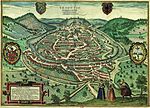University of Franche-Comté

The University of Franche-Comté (UFC) is a pluridisciplinary public French university located in Besançon, Franche-Comté, with decentralized campuses in Belfort, Montbéliard, Vesoul and Lons-le-Saunier. It is a founding member of the community of universities and institutions University of Burgundy - Franche-Comté (COMUE UBFC), headquartered in Besançon and which federates universities and other higher learning institutes in the Bourgogne-Franche-Comté region. With 28 research labs, 667 PhD students and 788 research professors in 2016–2017, the University of Franche-Comté is well represented in the research community. It collaborates with many organizations (University Hospital of Besançon, CNRS, INSERM, CEA, etc.). It has about 29,000 students, including nearly a third of scholarship students and 12% of foreign students. Its Centre for Applied Linguistics (CLA) is one of the world's leading schools for teaching French as a foreign language and French linguistics.
Excerpt from the Wikipedia article University of Franche-Comté (License: CC BY-SA 3.0, Authors, Images).University of Franche-Comté
Place de la Révolution, Besançon République
Geographical coordinates (GPS) Address External links Nearby Places Show on map
Geographical coordinates (GPS)
| Latitude | Longitude |
|---|---|
| N 47.240555555556 ° | E 6.0225 ° |
Address
Maison de l'Université
Place de la Révolution
25000 Besançon, République
Bourgogne-Franche-Comté, France
Open on Google Maps









